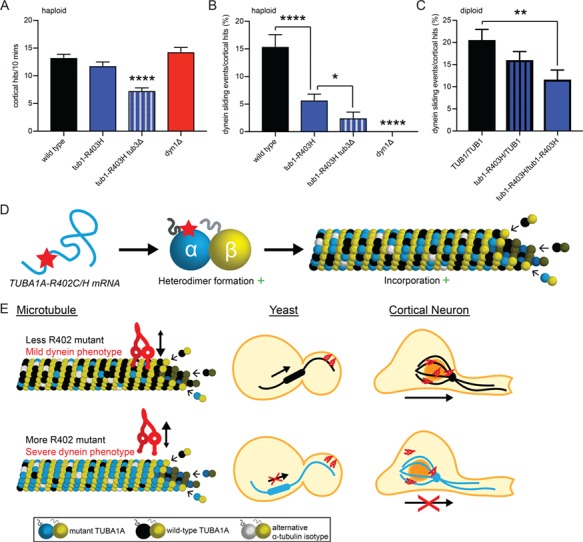Figure 7.

Dynein activity disruption scales with abundance of α-tubulin R402 mutant. (A) Quantification of microtubule–cortical hits in a 10 min period for the indicated strains. (B) Quantification of dynein sliding events normalized to microtubule–cortical hits in haploid cells with varying levels of tub1-R403H mutant, displayed as percentage. At least 27 cells were analyzed for each strain. Data are represented as mean ± SEM. Single asterisks indicate significant difference compared to WT, by t-test (P < 0.05). Quadruple asterisks indicate significant difference compared to WT, by t-test (P < 0.0001). Strains: WT, yJM1887, yJM1237; tub1-R403H, yJM2218; tub1-R403H tub3∆, yJM2654; dyn1∆, 1023. (C) Quantification of dynein sliding events normalized to microtubule–cortical hits in diploid cells with varying levels of tub1-R403H mutant, displayed as percentage. At least 30 cells were analyzed for each strain. Data are represented as mean ± SEM. Strains: WT, yJM2711; tub1-R403H/TUB1, yJM2655, yJM2656; tub1-R403H/tub1-R403H, yJM2712. (D–F) Model of α-tubulin R402C and R402H mechanism of action. (D) R402C/H mutants form appropriate tubulin heterodimers that incorporate into microtubules. (E) Disruption of dynein–microtubule interaction scales with abundance of R402C/H mutant in the microtubule. With less R402C/H mutant incorporation, dynein actively slides microtubules to orient the mitotic spindle in yeast cells and neurons can migrate in the developing cortex. With more R402C/H mutant incorporation, dynein cannot appropriately orient the mitotic spindle in yeast cells and neurons fail to migrate out of the ventricular zone.
